
A Walk on the Tundra
ᐅᖃᓕᒫᒐᕐᒥᒃ ᕿᒥᕐᕈᓂᖅ | Book Study
Design and layout copyright © 2019 Department of Education, Government of Nunavut
Text copyright © 2019 Department of Education, Government of Nunavut
Cover illustration copyright © 2018 by Qin Leng
Excerpts from A Walk on the Tundra reproduced with permission of Inhabit Media Inc., text copyright © 2018 by Anna Ziegler and Rebecca Hainnu, illustrations copyright © 2018 by Qin Leng
Developed and designed by Inhabit Education | www.inhabiteducation.com
All rights reserved. The use of any part of this publication reproduced, transmitted by any form or by any means, electronic, mechanical, photocopying, recording, or otherwise, or stored in a retrievable system, without written consent of the publisher, is an infringement of copyright law.
Inuktut Titiqqiriniq
This resource is part of Inuktut Titiqqiriniq, a comprehensive Inuktut literacy program that was created in Nunavut. Inuktut Titiqqiriniq was developed by Nunavut educators, linguists, and language consultants, with constant testing and input by Nunavut classroom teachers. Inuktut Titiqqiriniq provides instructional tools and resources to help students develop strong Inuktut language skills.
Inuktut Titiqqiriniq takes a holistic and balanced approach to language learning. Inuktut Titiqqiriniq considers all aspects of and opportunities for literacy development.
II ᐱᕈᖅᑐᑦ ᒥᒃᓵᓄᑦ
A Walk on the Tundra
Book Study
ᐅᖃᓕᒫᒐᕐᒥᒃ ᕿᒥᕐᕈᓂᖅ
Pre-reading Activity: Picture Walk
ᓂᐱᖃᕐᓗᓂ-ᐅᖃᓕᒫᕐᓂᖅ:
Read-Aloud: Part 1
ᑎᑎᕋᖃᑎᒌᖕᓂᖅ:
Shared Writing: Describing Tundra Plants
ᐱᓕᕆᐊᒃᓴᒃᑲᓐᓂᖅ:
Pre-reading Activity: Active Picture Walk
Read-Aloud: Part 2
ᐱᕈᖅᑐᑦ ᒥᒃᓵᓄᑦ
Table of Contents ᐅᖃᓕᒫᒐᐅᑉ ᒥᒃᓵᓄᑦ 4 About the Book ᐅᖃᓕᒫᒐᕐᒥᒃ ᕿᒥᕐᕈᓂᐅᑉ ᒥᒃᓵᓄᑦ 5 About this Book Study ᑐᖖᒐᕕᒋᔭᐅᔪᑦ ᐋᖅᑭᒋᐊᖅᑕᐅᓯᒪᓂᖏᓪᓗ 7 General Accommodations and Modifications ᑭᓱᙳᐊᑦ ᖃᓄᐃᑦᑑᓂᖏᑦ 8 Icon Descriptions ᐃᓚᖓ 1 10 Part 1
ᓯᕗᓂᐊᒍᑦ ᐱᓕᕆᐊᒃᓴᖅ: ᐊᔾᔨᙳᐊᑎᒎᕐᓂᖅ 10
ᐃᓗᓕᖏᑦ
ᐅᖃᓕᒫᕆᐅᖅᓴᓂᐅᑉ
ᐃᓚᖓ 1 16
ᓇᓗᓇᐃᔭᐃᓂᖅ ᐱᕈᖅᑐᓂᒃ 18
ᐊᑐᖅᓯᒪᔭᕐᓂᒃ 19 Extension Activity: Art Connection ᐃᓚᖓ 2 22 Part 2 ᐅᖃᓕᒫᕆᐅᖅᓴᓂᐅᑉ ᓯᕗᓂᐊᒍᑦ ᐱᓕᕆᐊᒃᓴᖅ: ᐱᓪᓚᕆᖖᒍᐊᕐᓂᖅ ᐊᔾᔨᖖᒍᐊᓂ ᐊᑐᕐᓗᓂ 22
ᓂᐱᖃᕐᓗᓂ-ᐅᖃᓕᒫᕐᓂᖅ: ᐃᓚᖓ 2 30
ᑎᑎᕋᐅᔭᕐᓂᖅ
The Dog’s
ᐱᓕᕆᐊᒃᓴᖅ:
Activity: How Does Inuujaq Change? ᐱᓕᕆᐊᒃᓴᒃᑲᓐᓂᖅ:
Extension Activity: Inuujaq on the Tundra ᐱᓕᒻᒪᒃᓴᕐᓂᖅ
Community
A WALK ON THE TUNDRA ᐱᓕᕆᐊᒃᓴᖅ: ᕿᒻᒥᐅᑉ ᐅᓪᓗᖓ 32
Activity:
Day
ᖃᓄᖅ ᐃᓅᔭᖅ ᐊᓯᔾᔨᖅᐸ? 35
ᐃᓅᔭᖅ ᓄᓇᒦᑦᑐᖅ 35
40 Pilimmaksarniq ᓄᓇᓕᖕᓂᑦ ᐃᓚᓕᐅᔾᔨᓂᖅ: ᖃᐅᔨᒪᔨᑕᖅ ᐅᓂᒃᑳᕆᐊᖅᓯᒪᔪᖅ 40
Inclusion Event: Expert Guest ᐱᓕᕆᐊᒃᓴᒃᑲᓐᓂᖅ: ᐊᓯᖕᓂᒃ ᐃᓕᓐᓂᐊᖅᑎᑦᑎᒋᑦ 41 Extension Activity: Teach Someone Else ᐊᕙᑎᒥᒃ ᑲᒪᑦᑎᐊᕐᓂᖅ 42 Avatittinnik Kamatsiarniq
ᐊᑐᓕᒃᑲᓐᓂᖅᓯᒪᔪᑦ ᓄᓇᐃᓐᓇᕐᒥ ᐱᕈᖅᑐᑦ 42 Activity:
Plants
ᓄᓇᓕᖕᓂ ᓴᓂᕐᓂᖅ 43 Extension Activity: Community Cleanup ᓱᓕᔪᓂᒃ ᑲᓲᑎᑦ: ᖃᐅᔨᓴᖅᑐᓕᕆᓂᖅ 56 Non-fiction Connections: Science
ᐱᕈᖅᑐᓂᒃ ᖃᐅᔨᓴᖅᑎᑦ 56 Activity:
ᐱᕈᖅᑐᑎᒎᕐᓂᖅ 57
Activity:
ᐱᓕᕆᐊᒃᓴᒃᑲᓐᓃᑦ ᑕᒪᐃᓐᓄᑦ ᐃᓕᓐᓂᐊᒐᒃᓴᓄᑦ 64
the Subjects
ᐱᓕᕆᐊᒃᓴᖅ:
Recycled Tundra
ᐱᓕᕆᐊᒃᓴᒃᑲᓐᓂᖅ:
ᐱᓕᕆᐊᒃᓴᖅ:
Plant Detectives ᐱᓕᕆᐊᒃᓴᒃᑲᓐᓂᖅ:
Extension
Plant Walk
Extension Activities across
About the Book
During the short Arctic summers, the tundra—covered most of the year by snow and ice—becomes filled with colourful flowers, mosses, shrubs, and lichens. These hardy little plants transform the northern landscape as they take advantage of the warmer weather and long hours of sunlight. Caribou, lemmings, snow buntings, and many other wildlife species depend on tundra plants for food and nutrition, but they are not the only ones…
ᐱᕈᖅᑐᑦ ᒥᒃᓵᓄᑦ / A Walk on the Tundra follows Inuujaq, a bored little girl who travels with her grandmother onto the tundra. There, Inuujaq learns that these tough plants are much more important to Inuit than she originally believed.

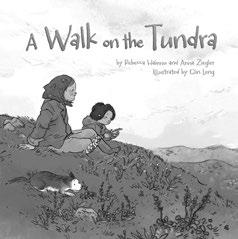
4 ᐱᕈᖅᑐᑦ ᒥᒃᓵᓄᑦ ᐅᖃᓕᒫᒐᐅᑉ ᒥᒃᓵᓄᑦ
About this Book Study
Designed for students in Grades 3 to 5, this book study offers a collection of language arts activities for Inuktitut and English based on the book ᐱᕈᖅᑐᑦ ᒥᒃᓵᓄᑦ / A Walk on the Tundra by Rebecca Hainnu and Anna Ziegler. It can be used as part of your balanced literacy approach to instruction and contains activities that use read-alouds, modelled writing, shared writing, and independent writing.
Other activities in the book study aim to build students’ language arts knowledge and skills, and include the following:
• Pre-reading activities get students excited about the text and engage their thinking about the knowledge and skills you plan to teach.
• Extension activities challenge students to continue developing their skills and take advantage of the unique creative opportunities inspired by the text. They are very useful when students have mastered content and need an extra challenge.
Teachers should select the activities that are best suited to the strengths and needs of their students.
Objectives
This resource provides activities based on ᐱᕈᖅᑐᑦ ᒥᒃᓵᓄᑦ / A Walk on the Tundra by Rebecca Hainnu and Anna Ziegler. By studying this story, students will:
• Engage in a variety of listening, speaking, reading, writing, viewing, and representing activities
• Exercise and develop oral communication skills
• Identify how characters change over the course of a story
• Learn and practise key reading strategies and behaviours
• Learn about different tundra plants and what they can be used for
• Consider the behaviours in positive relationships
A WALK ON THE TUNDRA 5 ᐅᖃᓕᒫᒐᕐᒥᒃ ᕿᒥᕐᕈᓂᐅᑉ ᒥᒃᓵᓄᑦ
Community Inclusion
Community involvement in the classroom leads to meaningful learning for students and strengthens the bonds between school and community. When community members participate in students’ learning, students are able to see the importance of what they do in the classroom. Local experts are also given the opportunity to pass on critical local knowledge and perspectives to the next generation. This book study concludes with a community inclusion event in which a local expert is invited into the classroom to share knowledge about local plants found on the tundra.
Notes to Educators
Although this resource was created to support Inuktitut and English educators, the teacher instructions in this resource are in English, with student materials available in Inuktitut and English. This decision reflects the recommendations we received from our Inuktitut working group and several focus group meetings with Nunavut educators. The rationale was that having teacher instructions in English avoids dialectal issues with understanding the content and increases accessibility to teachers across Nunavut.
There should be a discussion within your school about which classes will use the resource so that it isn’t repeated from year to year.
In this book study, students will mostly read the text as a class through teacher-led read-alouds. This ensures that the text can be understood by students with a wide variety of reading levels and enables students with different reading levels to work together on language arts skills and concepts. This book study is designed to be used as part of a balanced literacy approach to instruction that includes guided reading and independent reading, both of which target students’ reading levels directly.
You can complete this book study with a single copy of the text. However, if you feel that students would benefit from reading from their own copy, you can use a class set.
Additional Resources
This book study is part of a series. Additional resources have been created to accompany the different book studies in the series. These resources include posters, films, activity/reading/photo card sets, and audiobooks. See the “ᐃᓄᒃᑐᑦ ᑎᑎᖅᑭᕆᓂᖅ
” / “Inuktut Titiqqiriniq Resource Checklist” located in the ᐃᓄᒃᑐᑦ ᑎᑎᖅᑭᕆᓂᖅ / Inuktut Titiqqiriniq resource binders to learn about what additional resources may be available for this book study.
6 ᐱᕈᖅᑐᑦ ᒥᒃᓵᓄᑦ
ᐊᑐᕋᔅᓴᓄᑦ ᖃᐅᔨᒪᔅᔪᑎ
General Accommodations and Modifications
Outlined below are some useful teaching strategies that may assist those students who struggle with their learning or demonstrate some difficulty with everyday classroom tasks. Remember that everyone learns in different ways, and we cannot expect that all students will respond in the same way to a specific teaching strategy. Students, teachers, and parents must work together to maximize each student’s learning potential and to create a positive, productive, and successful classroom community.
Environmental Accommodations
• Arrange seating to reduce distractions.
• Provide students with a place to keep supplies, books, and other materials away from their work area.
• Allow breaks between tasks.
Adaptations to Lesson Presentations
• Give a structured overview before the lesson.
• Provide verbal and written instructions.
• Establish routines that enable students to check understanding with a peer.
• Provide frequent repetition of important instructions.
• Ensure that students can hear instructions by arranging seating appropriately or using an FM system (if available).
Adaptations to Assignments and Projects
• Shorten assignments and/or divide assignments into parts.
• Provide extended time for students to complete assignments.
• Use peer support and mentoring (select a classroom buddy).
• Provide opportunities for students to demonstrate understanding of material using a variety of media, including oral presentations, visual arts/illustrations, audio- or videotaped assignments, bulletin board displays, and dramatizations.
• Provide assistance with organization and planning of classwork and/or homework.
A WALK ON THE TUNDRA 7 ᑐᖖᒐᕕᒋᔭᐅᔪᑦ ᐋᖅᑭᒋᐊᖅᑕᐅᓯᒪᓂᖏᓪᓗ
Icon Descriptions
Icons are located at the beginning of each activity and indicate the type of learning opportunities included in the activity.
READING Students will read the text. Students will use one of the following approaches to engage with written text: listening to teacher-led read-alouds, participating in shared and performance reading, reading in pairs or in small groups, or reading independently with support from the teacher.
VOCABULARY Students will work with vocabulary from the text. Students will practise integrating unfamiliar vocabulary into written or oral communication.
ORAL COMMUNICATION Students will learn and practise oral communication skills. Students will participate in a whole-class, small-group, or pairs discussion. Students may also prepare and deliver oral presentations.
VIEWING Students will view a multimedia text. Students may view films or artwork in order to support their comprehension of the text or to explore elements of media.
WRITING Students will develop their writing skills. Students will observe modelled writing, participate in shared writing, or write independently.
CONNECTING Students will make a connection between the text and themselves, between the text and other texts, or between the text and the world.
8 ᐱᕈᖅᑐᑦ ᒥᒃᓵᓄᑦ ᑭᓱᙳᐊᑦ ᖃᓄᐃᑦᑑᓂᖏᑦ
DECODING AND COMPREHENSION Students will learn and practise decoding and comprehension. Students will work on a critical reading skill, competency, or behaviour necessary for reading and comprehending text.
REFLECTION Students will reflect on their learning to think about how they learn or to discover personal connections to learning.
VISUAL REPRESENTATION Students will create a visual representation. Visual representations include drawings or artwork and are used to respond to the text or to express ideas.
RESEARCH SKILLS Students will develop one or more research skills. Students will work on skills such as generating questions, developing a research plan, locating sources, evaluating sources, gathering and organizing information, forming conclusions, and communicating research results.
HANDOUTS This activity includes one or more handouts. These handouts include an Inuktitut and an English version and can be found in the pages immediately following each activity.
COMMUNITY INCLUSION Students will experience a community perspective relating to an issue from the text. Students will observe storytelling sessions or demonstrations put on by community members or go out into the community to participate in learning activities.
A WALK ON THE TUNDRA 9
ᐃᓚᖓ 1
Part 1
ᐅᖃᓕᒫᕆᐅᖅᓴᓂᐅᑉ ᓯᕗᓂᐊᒍᑦ ᐱᓕᕆᐊᒃᓴᖅ: ᐊᔾᔨᙳᐊᑎᒎᕐᓂᖅ
Pre-reading Activity: Picture Walk [15 min]
Overview
Students will participate in a picture walk for the first part of ᐱᕈᖅᑐᑦ ᒥᒃᓵᓄᑦ / A Walk on the Tundra (from the beginning to the part where Inuujaq and Silaaq are eating qunnguliit).
Materials
• A copy of ᐱᕈᖅᑐᑦ ᒥᒃᓵᓄᑦ / A Walk on the Tundra
• ᑐᓂᐅᖅᑲᒐᖅ 1: ᐅᓂᒃᑳᕐᒥ ᖃᓄᐃᑦᑐᖃᕐᓂᐊᖅᐸ? /
Handout 1: What Will Happen in the Story?
Preparation
• Review the story.
• Review the suggested discussion prompts and decide which prompts you will use during the picture walk.
• Photocopy ᑐᓂᐅᖅᑲᒐᖅ 1: ᐅᓂᒃᑳᕐᒥ
/ Handout 1: What Will Happen in the Story? (one for each student).
Teaching Tip
A picture walk is a shared activity between the teacher and students that involves looking at each of the pictures in a text before reading, and sharing ideas about the book. Picture walks are used to:
• Spark interest in a story
• Allow students to make predictions
• Encourage students to make connections to the story
Activity
1. Have students sit together in a shared space. Hold up your copy of ᐱᕈᖅᑐᑦ ᒥᒃᓵᓄᑦ / A Walk on the Tundra and make sure students can see it. Go through the pictures in the first half of the book with students, stopping and looking at each illustration in detail. When you get to each illustration, you can ask students questions to start a discussion, or model thinking about the text by telling students your thoughts about the pictures and the book.
2. Suggested discussion prompts: Here are some questions you can ask during the picture walk. For each discussion prompt, turn to the page pictured in the thumbnail next to the prompt.
ᐅᖃᓕᒫᒐᕐᒥᒃ ᕿᒥᕐᕈᓂᖅ Book Study 10 ᐱᕈᖅᑐᑦ ᒥᒃᓵᓄᑦ
ᖃᓄᐃᑦᑐᖃᕐᓂᐊᖅᐸ?
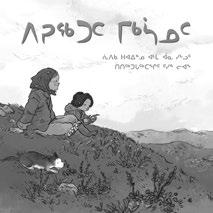
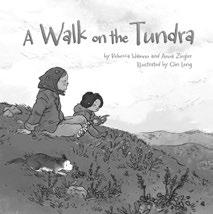


• Look at the cover. Read the title, the names of the authors, and the name of the illustrator. Ask: Who is in the picture? What do you think they are doing? How do you know?
• How do you think the girl on the steps is feeling? Why do you think that?
• What do you think is happening in this picture?
A WALK ON THE TUNDRA 11 ᐃᓚᖓ 1 Part 1
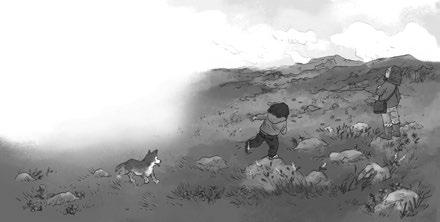
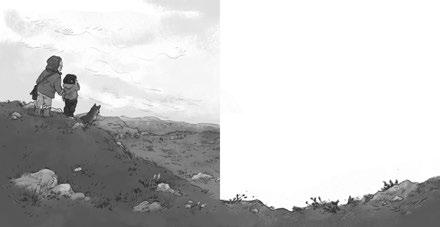

• Where are the characters going? What makes you think that?
• Imagine you were there with the characters. How would you feel? Why?
• What are the characters looking at?
ᐅᖃᓕᒫᒐᕐᒥᒃ ᕿᒥᕐᕈᓂᖅ Book Study 12 ᐱᕈᖅᑐᑦ ᒥᒃᓵᓄᑦ

3. Stop at page 13 (where Inuujaq and Silaaq are eating qunnguliit).
4. Distribute ᑐᓂᐅᖅᑲᒐᖅ 1:
/ Handout 1: What Will Happen in the Story?. Have students draw a picture of what they think will happen in the story and write a sentence to go with their picture.
• This picture reminds me of (share a time when you were on the land or enjoying the company of a loved one). What does it remind you of?
A WALK ON THE TUNDRA 13 ᐃᓚᖓ 1 Part 1
ᖃᓄᐃᑦᑐᖃᕐᓂᐊᖅᐸ?
ᐅᓂᒃᑳᕐᒥ
ᐊᑎᖅ: ᑐᓂᐅᖅᑲᒐᖅ 1 ᐅᖃᓕᒫᕆᐅᖅᓴᓂᐅᑉ ᓯᕗᓂᐊᒍᑦ ᐱᓕᕆᐊᒃᓴᖅ: ᐊᔾᔨᙳᐊᑎᒎᕐᓂᖅ • ᒪᒃᐱᖅᑐᒐᖅ 1 ᐊᑕᐅᓯᐅᑎᓪᓗᒍ ᐅᓂᒃᑳᕐᒥ ᖃᓄᐃᑦᑐᖃᕐᓂᐊᖅᐸ? ᐅᓂᒃᑳᕐᒥ ᖃᓄᐃᑦᑐᖃᕐᓂᐊᖅᐸ? ᑎᑎᕋᐅᔭᕆᑦ ᐅᓂᒃᑳᕐᒥ ᖃᓄᐃᓐᓂᐊᕋᓱᒋᔭᕐᓂᒃ. ᐅᓂᒃᑳᕐᒥ ᖃᓄᐃᑦᑐᖃᕐᓂᐊᖅᐸ? ᑎᑎᕋᐅᓯᖃᕆᑦ ᐅᓂᒃᑳᕐᒥ ᖃᓄᐃᓐᓂᐊᕋᓱᒋᔭᕐᓂᒃ.
What Will Happen in the Story?
What will happen in the story? Draw what you predict will happen.
What will happen in the story? Write what you predict will happen.
Name: Handout 1 Pre-reading
1
1
Activity: Picture Walk •
of
ᓂᐱᖃᕐᓗᓂ-ᐅᖃᓕᒫᕐᓂᖅ: ᐃᓚᖓ 1
Read-Aloud: Part 1 [15 min]
Overview
Students will listen to a read-aloud of the first part of ᐱᕈᖅᑐᑦ ᒥᒃᓵᓄᑦ/ A Walk on the Tundra (from the beginning to the part where Inuujaq and Silaaq are eating qunnguliit) and discuss the story with a focus on characters and the use of different plants.
Materials
• A copy of ᐱᕈᖅᑐᑦ ᒥᒃᓵᓄᑦ / A Walk on the Tundra
Preparation
• Review the story and the suggested discussion prompts for during and after reading.
Teaching Tip
If your class is reading the English version of the book, it is very important that you spend some time learning to pronounce the Inuktitut words and names before reading the story to your students. There is a glossary of Inuktitut words and phrases at the back of the book, with pronunciation guides.
Activity
Before Reading
1. Give students the opportunity to share their drawings of what they think will happen in the story from the previous activity.
2. Tell students that they will be reading a story about Inuujaq, a girl who goes out on the tundra with her grandmother to collect some plants. While they walk, Inuujaq’s grandmother teaches her about ways to use the many different plants they see.
During Reading
3. Read the book out loud to the class up to the page where Inuujaq and Silaaq are eating qunnguliit. This completes part 1 of the book.
4. Suggested discussion prompts: Here are some examples of questions you can pause and ask while reading the story. If you are doing more than one read-aloud, you can choose different questions for each read-aloud.
• What does Inuujaq want to do? Why can’t she do it?
• Why does Inuujaq decide to go with her grandmother?
• Where do you think Inuujaq and Silaaq are going?
• How do you think Silaaq feels in this spot on the tundra? Why do you think that?
• Do you think Inuujaq will eat the qunnguliit? What do you think it will taste like?
• Inuujaq likes the qunnguliit. What do you think her grandmother will show her next?
ᐅᖃᓕᒫᒐᕐᒥᒃ ᕿᒥᕐᕈᓂᖅ Book Study 16 ᐱᕈᖅᑐᑦ ᒥᒃᓵᓄᑦ
After Reading
5. Suggested discussion prompts: Here are some examples of questions you can ask about the story. Your students may find it helpful if you return to the illustration for the part of the story you are discussing.
• Who are the characters in the book?
• How does Inuujaq feel about having a curfew in the summer? How do you know?
• Inuujaq tells her grandmother that she is hungry, but her grandmother just smiles and keeps walking. Why do you think she does that?
• This book makes me wonder what my family members used to do when they were children. What do you think your family members liked to do when they were young?
• What do the qunnguliit taste like?
• Inuujaq goes for a walk with her grandmother even though she doesn’t really want to. Do you think she is glad she came?
• What do you think will happen in the next part of the book?
A WALK ON THE TUNDRA 17 ᐃᓚᖓ 1 Part 1
Activity
ᑎᑎᕋᖃᑎᒌᖕᓂᖅ:
ᓇᓗᓇᐃᔭᐃᓂᖅ
Shared Writing: Describing Tundra Plants [25 min]
Overview
Students will work with the teacher to describe different tundra plants using the five senses. Then, students will write a few sentences about a tundra plant using descriptive words.
Materials
• A copy of ᐱᕈᖅᑐᑦ ᒥᒃᓵᓄᑦ / A Walk on the Tundra
• ᑐᓂᐅᖅᑲᒐᖅ 2:
/ Handout 2: Describing Tundra Plants
• Whiteboard or chart paper
• Colouring utensils
Preparation
• Photocopy ᑐᓂᐅᖅᑲᒐᖅ 2: ᓇᓗᓇᐃᔭᐃᓂᖅ ᐱᕈᖅᑐᓂᒃ / Handout 2: Describing Tundra Plants (one for each student).
• Write Describing Tundra Plants on the whiteboard.
• Draw a T-chart underneath Describing Tundra Plants. Label the left-hand column Descriptive Words. Label the right-hand column Types of Tundra Plants
Teaching Tip
In a shared writing lesson, the teacher works with students to compose a piece of writing. In most cases, the teacher suggests the topic for the sentence and begins writing the sentence, calling for students’ suggestions whenever possible.
1. Gather students in a shared space. Have a whole-class discussion about how Inuujaq’s grandma teaches her about the different plants on the tundra. Ask: How does Inuujaq learn about the different plants on the tundra? Talk with students about the different ways that Inuujaq’s grandma teaches Inuujaq about qunnguliit:
• Inuujaq’s grandma shows her the qunnguliit on the tundra.
• Then, she gives the qunnguliit to Inuujaq to hold in her hands.
• Then, because qunnguliit is a kind of tundra plant you can eat, she tells Inuujaq to eat some.
• Before Inuujaq eats the qunnguliit, she holds it under her nose.
2. Ask: Which of the five senses did Inujaaq use to learn about the qunnguliit (sight, sound, smell, taste, and touch)? Talk with students about how Inujaaq used sight, smell, taste, and touch. Remind students that sometimes we can also hear plants, like when we step on them and crunch them or when they move in the wind. Explain to students that thinking about the five senses can help us describe things in writing.
3. Work with students to create a list of words that could be used to describe plants. Reread the part of the book in which Inuujaq learns about qunnguliit. Ask students to listen for describing words in the text as you read. After reading the section, ask students to share any describing words they heard in the text. Record students’ responses on the whiteboard in the left-hand column (Descriptive Words). Consider the list of describing words below for examples:
• “funny-looking”
• “green”
• “heart-shaped”
• “tall”
• “crumpled”
• “little”
• “sweet”
• “sour”
• “delicious”
ᐅᖃᓕᒫᒐᕐᒥᒃ ᕿᒥᕐᕈᓂᖅ Book Study 18 ᐱᕈᖅᑐᑦ ᒥᒃᓵᓄᑦ
ᐱᕈᖅᑐᓂᒃ
ᓇᓗᓇᐃᔭᐃᓂᖅ ᐱᕈᖅᑐᓂᒃ
4. Next, create a list of tundra plants that students already know. Ask: What types of tundra plants do you know? Record students’ responses on the whiteboard in the right-hand column (Types of Tundra Plants). Consider the list below for examples:
• Qunnguliit (mountain sorrel)
• Uqaujait (Arctic willow)
• Akpiit (cloudberries)
• Kigutangirnaak (blueberries)
• Kanguujaq (Arctic cotton)
5. Choose one of the tundra plants from the list on the whiteboard and ask students to help you write two to three sentences that use describing words. Remind students to think about their different senses when trying to come up with describing words. You might write something like, I think Arctic cotton would feel very fluffy, like a piece of fur. The stems are long and skinny. Arctic cotton would be quiet in the wind because it’s so soft.
6. Tell students that it is their turn to write about a tundra plant. Distribute ᑐᓂᐅᖅᑲᒐᖅ 2:
ᐱᕈᖅᑐᓂᒃ / Handout 2:
Describing Tundra Plants. Tell students to use ideas from the whiteboard and/or their own ideas to write three sentences about a tundra plant. Encourage students to use at least three describing words. Tell students to draw a picture to go with their sentences.
7. Consider displaying students’ work on a bulletin board. You can call the display Describing the Tundra
Teaching Tip
During this activity and throughout this book study, be sure to remind students never to eat plants they find without an adult present who can confirm that they have the correct plant. Explain that some plants are not meant to be eaten and can make people very sick. ᐱᓕᕆᐊᒃᓴᒃᑲᓐᓂᖅ:
Extension Activity: Art Connection
• Provide an assortment of art supplies. Have students create a visual representation of their favourite tundra plant.
A WALK ON THE TUNDRA 19 ᐃᓚᖓ 1 Part 1
ᓇᓗᓇᐃᔭᐃᓂᖅ
ᑎᑎᕋᐅᔭᕐᓂᖅ ᐊᑐᖅᓯᒪᔭᕐᓂᒃ
ᑎᑎᕋᖃᑎᒌᖕᓂᖅ: ᓇᓗᓇᐃᔭᐃᓂᖅ ᐱᕈᖅᑐᓂᒃ • ᒪᒃᐱᖅᑐᒐᖅ 1 ᐊᑕᐅᓯᐅᑎᓪᓗᒍ ᐊᑎᖅ: ᑐᓂᐅᖅᑲᒐᖅ 2
ᐱᕈᖅᑐᖁᑏᑦ ᑎᑎᕋᐅᔭᕈᒃ.
ᓇᓗᓇᐃᔭᐃᓂᖅ ᐱᕈᖅᑐᓂᒃ
Describing Tundra Plants
Draw your plant.
Shared Writing: Describing Tundra Plants • 1 of 1 Name: Handout 2
ᐃᓚᖓ 2
Part 2
ᐅᖃᓕᒫᕆᐅᖅᓴᓂᐅᑉ ᓯᕗᓂᐊᒍᑦ
ᐱᓕᕆᐊᒃᓴᖅ: ᐱᓪᓚᕆᖖᒍᐊᕐᓂᖅ
ᐊᔾᔨᖖᒍᐊᓂ ᐊᑐᕐᓗᓂ
Pre-reading Activity: Active Picture Walk [15 min]
Overview
Students will participate in an active picture walk for the second part of ᐱᕈᖅᑐᑦ ᒥᒃᓵᓄᑦ / A Walk on the Tundra (from the part where Silaaq remembers the childhood summer when she was hungry to the end of the book). Then, students will draw and write about a tundra plant from the book.
Materials
• A copy of ᐱᕈᖅᑐᑦ ᒥᒃᓵᓄᑦ / A Walk on the Tundra
• ᑐᓂᐅᖅᑲᒐᖅ 3: ᓄᓇᒥ ᐱᕈᖅᑐᖅ / Handout 3: Tundra Plant
• ᑐᓂᐅᖅᑲᒐᖅ 4: ᐱᕈᖅᑐᑦ ᐊᔾᔨᙳᐊᑦ ᑎᑎᕋᖅᓯᒪᔪᑦ / Handout 4: Plant Picture Cards
Preparation
• Review the story.
• Review the suggested discussion prompts and decide which prompts you will use during the picture walk.
• Photocopy ᑐᓂᐅᖅᑲᒐᖅ 3: ᓄᓇᒥ ᐱᕈᖅᑐᖅ / Handout 3: Tundra Plant (one for each student).
• Photocopy ᑐᓂᐅᖅᑲᒐᖅ 4: ᐱᕈᖅᑐᑦ ᐊᔾᔨᙳᐊᑦ
/ Handout 4: Plant Picture Cards (one for each student).
Teaching Tip
An active picture walk is similar to a regular picture walk, but small groups of students act out the picture they see for the rest of the class. Active picture walks are used to:
• Encourage students to consider the expressions and potential emotions of the characters
• Allow students to move around and physically engage with the story
• Create a fun, enjoyable atmosphere while reading
Activity
1. Have students sit together in a shared space. Hold up your copy of ᐱᕈᖅᑐᑦ ᒥᒃᓵᓄᑦ / A Walk on the Tundra and make sure students can see it. Go through the pictures in the second half of the book with students, stopping and looking at each illustration in detail. When you get to each illustration, ask a few student volunteers to act out what they see in the picture. Encourage volunteers to look at the characters’ facial expressions and body language.
2. After the student volunteers act out their picture, ask students to comment on both the picture and the way their classmates acted out the picture. Ask the volunteers how they felt when they were pretending to be the characters.
3. Suggested discussion prompts: Here are some questions you can ask during the picture walk. For each discussion prompt, turn to the page pictured in the thumbnail next to the prompt.
ᐅᖃᓕᒫᒐᕐᒥᒃ ᕿᒥᕐᕈᓂᖅ Book Study 22 ᐱᕈᖅᑐᑦ ᒥᒃᓵᓄᑦ
ᑎᑎᕋᖅᓯᒪᔪᑦ
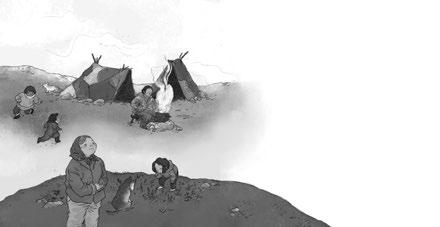

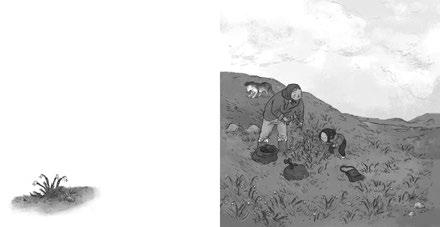
• There are two different scenes happening in this picture. What do you think is happening?
• Look at Inuujaq. How do you think she feels here? Why?
• What are Inuujaq and Silaaq doing?
A WALK ON THE TUNDRA 23 ᐃᓚᖓ 2 Part 2
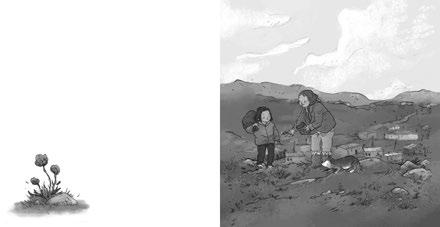


• If you were there with Inuujaq and Silaaq, how do you think you would feel? Would you be happy, sad, warm, cold, or something else? Why do you think that?
• Look at the footprints across these pages. Why do you think the illustrator drew the footprints?
• What do you see in these pictures?
ᐅᖃᓕᒫᒐᕐᒥᒃ ᕿᒥᕐᕈᓂᖅ Book Study 24 ᐱᕈᖅᑐᑦ ᒥᒃᓵᓄᑦ
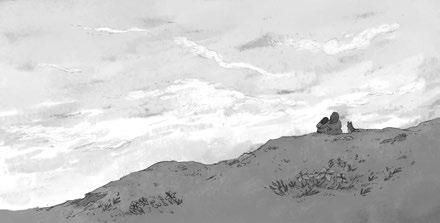
4. Distribute ᑐᓂᐅᖅᑲᒐᖅ 3: ᓄᓇᒥ ᐱᕈᖅᑐᖅ / Handout 3: Tundra Plant and ᑐᓂᐅᖅᑲᒐᖅ 4:
/ Handout 4: Plant Picture Cards to each student.
5. Have students choose one plant from ᑐᓂᐅᖅᑲᒐᖅ 4: ᐱᕈᖅᑐᑦ ᐊᔾᔨᙳᐊᑦ
ᑎᑎᕋᖅᓯᒪᔪᑦ / Handout 4: Plant Picture Cards Have students complete ᑐᓂᐅᖅᑲᒐᖅ 3: ᓄᓇᒥ
ᐱᕈᖅᑐᖅ / Handout 3: Tundra Plant by drawing the plant, labelling the plant, and then writing one or two sentences about the plant. Tell students that their sentences can be facts about the plant that they remember from the book or sentences that describe the plant using one or more of the five senses.
• How do you think Silaaq feels here? Why?
Teaching Tip
Do not feel that you must have a discussion about both the student volunteers’ acting and the regular discussion prompts. If you have a good discussion about the scene students have acted out, that is enough to stimulate students’ thinking about the book.
If you prefer, you can also run this activity like a traditional picture walk, using the suggested prompts or some of your own.
A WALK ON THE TUNDRA 25 ᐃᓚᖓ 2 Part 2
ᐱᕈᖅᑐᑦ ᐊᔾᔨᙳᐊᑦ ᑎᑎᕋᖅᓯᒪᔪᑦ
ᐱᕈᖅᑐᖅ
ᐅᖃᓕᒫᕆᐅᖅᓴᓂᐅᑉ ᓯᕗᓂᐊᒍᑦ ᐱᓕᕆᐊᒃᓴᖅ: ᐱᓪᓚᕆᖖᒍᐊᕐᓂᖅ ᐊᔾᔨᖖᒍᐊᓂ ᐊᑐᕐᓗᓂ • ᒪᒃᐱᖅᑐᒐᖅ 1 ᐊᑕᐅᓯᐅᑎᓪᓗᒍ ᐊᑎᖅ: ᑐᓂᐅᖅᑲᒐᖅ 3 ᑎᑎᕋᐅᓯᕆᒍᒃ ᐱᕈᖅᑐᖅ. ᓄᓇᒥ
ᓂᕈᐊᕆᑦ ᓄᓇᐃᓐᓇᕐᒥᑦ ᐱᕈᖅᑐᒥᒃ. ᑎᑎᕋᐅᔭᕈᒃ. ᓇᓗᓇᐃᕈᒃ.
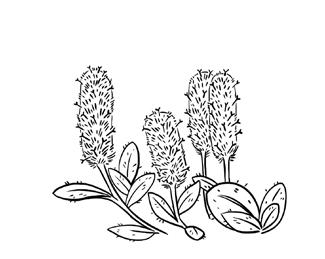

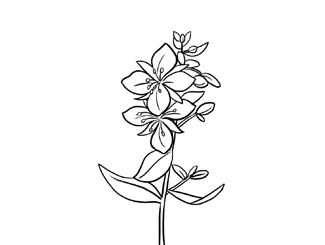


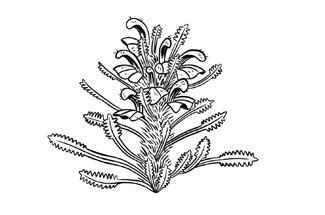
ᐊᑎᖅ: ᑐᓂᐅᖅᑲᒐᖅ 4 ᐅᖃᓕᒫᕆᐅᖅᓴᓂᐅᑉ ᓯᕗᓂᐊᒍᑦ ᐱᓕᕆᐊᒃᓴᖅ: ᐱᓪᓚᕆᖖᒍᐊᕐᓂᖅ ᐊᔾᔨᖖᒍᐊᓂ ᐊᑐᕐᓗᓂ • ᒪᒃᐱᖅᑐᒐᖅ 1 ᐊᑕᐅᓯᐅᑎᓪᓗᒍ ᐱᕈᖅᑐᑦ ᐊᔾᔨᙳᐊᑦ ᑎᑎᕋᖅᓯᒪᔪᑦ ᐊ’ᐋᓵᖅ ᖁᖑᓖᑦ ᐅᔾᔪᓐᓇᖅ ᐅᖃᐅᔭᐃᑦ ᕿᔪᒃᑖᑦ ᐸᐅᓐᓇᐃᑦ
Tundra
Plant
Choose a tundra plant. Draw it. Label it.
Write about the plant.
Pre-reading Activity: Active Picture Walk • 1 of 1 Name: Handout 3
Plant Picture Cards

uqaujait

qijuktaat

paunnait

qunnguliit

ujjunnaq

Pre-reading Activity: Active Picture Walk • 1 of 1
Name: Handout 4
a’aasaaq
ᓂᐱᖃᕐᓗᓂ-ᐅᖃᓕᒫᕐᓂᖅ: ᐃᓚᖓ 2
Read-Aloud: Part 2 [15 min]
Overview
Students will listen to a read-aloud of the last part of ᐱᕈᖅᑐᑦ ᒥᒃᓵᓄᑦ / A Walk on the Tundra (from the part where Silaaq is remembering her childhood to the end) and discuss the story with a focus on characters and the uses of different plants.
Materials
• A copy of ᐱᕈᖅᑐᑦ ᒥᒃᓵᓄᑦ / A Walk on the Tundra
Preparation
• Review the story and the suggested discussion prompts for during and after reading.
Activity
Before Reading
1. Have students share what they remember from the first part of the book. Ask students what they think will happen in the next part of the book.
During Reading
2. Read the book out loud to the class from the part where Silaaq is remembering her childhood to the end. This completes part 2 of the book.
3. Suggested discussion prompts: Here are some examples of questions you can pause and ask while reading the story. If you are doing more than one read-aloud, you can choose different questions for each read-aloud.
• How do you think Silaaq feels when her grandmother gives her broth made from qunnguliit?
• Why does Silaaq want to find the qijuktaat?
• The author uses a lot of describing words to explain what the qijuktaat is like. What are some of those words?
• Why do you think Inuujaq is so excited to cook with her grandmother?
Teaching Tip
If you are reading the English version of the book, it is very important that you spend some time learning to pronounce the Inuktitut words and names before reading the story to your students. There is an excellent glossary of Inuktitut words and phrases at the back of the book, with pronunciation guides.
• Silaaq describes three different plants. Which one do you think you’d like the best? Why?
• Why do you think Inuujaq decides to pick up the pop can she threw into the ditch that morning?
• Do you think Silaaq had fun sharing her knowledge with Inuujaq? Why do you think that?
ᐅᖃᓕᒫᒐᕐᒥᒃ ᕿᒥᕐᕈᓂᖅ Book Study 30 ᐱᕈᖅᑐᑦ ᒥᒃᓵᓄᑦ
After Reading
4. Suggested discussion prompts: Here are some examples of questions you can ask about the story. Your students may find it helpful if you return to the illustration for the part of the story you are discussing.
• Imagine that you could only get plants to eat from around your community. Which ones would you find a lot of? Which plants would you not be able to find?
• What was your favourite part of the story? Why did you like it?
• Do you think Inuujaq will enjoy the tea she is making from the a’aasaaq? Why?
• This book reminds me of when my grandmother taught me (share something your grandmother or another older relative taught you). What have you learned from your grandparents?
• What did you learn about plants from this story?
A WALK ON THE TUNDRA 31 ᐃᓚᖓ 2 Part 2
ᐱᓕᕆᐊᒃᓴᖅ: ᕿᒻᒥᐅᑉ ᐅᓪᓗᖓ
Activity: The Dog’s Day [25 min]
Overview
Students will work to write a short story about the day from Inuujaq’s dog’s perspective.
Materials
• A copy of ᐱᕈᖅᑐᑦ ᒥᒃᓵᓄᑦ / A Walk on the Tundra
• ᑐᓂᐅᖅᑲᒐᖅ 5: ᕿᒻᒥᐅᑉ ᐅᓪᓗᖓ / Handout 5: The Dog’s Day
• Whiteboard or chart paper
Preparation
• Photocopy ᑐᓂᐅᖅᑲᒐᖅ 5: ᕿᒻᒥᐅᑉ ᐅᓪᓗᖓ / Handout 5: The Dog’s Day (one for each student).
Activity
1. Remind students that while reading ᐱᕈᖅᑐᑦ ᒥᒃᓵᓄᑦ / A Walk on the Tundra , they learned a lot about what Inuujaq and Silaaq say and do. Remind students that there is also a dog in the story. Ask: What did the dog think about the day?
2. Explain to students that they will write a short story that shows what the dog is thinking throughout the day. Encourage students to pretend they are the dog when they write, using describing words to add details to their story.
3. Distribute ᑐᓂᐅᖅᑲᒐᖅ 5: ᕿᒻᒥᐅᑉ ᐅᓪᓗᖓ / Handout 5: The Dog’s Day. Provide students with time to write. Encourage them to use the pictures on the handout to help them think of ideas as they write.
4. Display students’ writing in your classroom.
ᐅᖃᓕᒫᒐᕐᒥᒃ ᕿᒥᕐᕈᓂᖅ Book Study 32 ᐱᕈᖅᑐᑦ ᒥᒃᓵᓄᑦ


ᐱᓕᕆᐊᒃᓴᖅ: ᕿᒻᒥᐅᑉ ᐅᓪᓗᖓ • ᒪᒃᐱᖅᑐᒐᖅ 1 ᐊᑕᐅᓯᐅᑎᓪᓗᒍ ᐊᑎᖅ: ᑐᓂᐅᖅᑲᒐᖅ 5 ᕿᒻᒥᐅᑉ
ᑎᑎᕋᐅᓯᕆᒍᒃ ᕿᒻᒥᐅᑉ ᐅᓪᓗᖓ ᐃᓅᔭᖅ ᓯᓛᕐᓗ ᐱᖃᑎᒋᓪᓗᒋᒃ. ᓇᓗᓇᐃᔭᖅᓯᓯᒪᔪᓂᒃ ᐅᖃᐅᓯᕐᓂᒃ ᐊᑐᕐᓗᑎᒃ ᐅᓂᒃᑳᓕᐊᑦ ᓇᓗᓇᐃᔭᕆᐊᒃᑲᓐᓂᕈᒃ.
ᐅᓪᓗᖓ
The Dog’s Day


Write about the dog’s day with Inuujaq and Silaaq. Use describing words to add details to your story.
Activity: The Dog’s Day • 1 of 1 Name: Handout 5
ᐱᓕᕆᐊᒃᓴᖅ:
ᖃᓄᖅ ᐃᓅᔭᖅ ᐊᓯᔾᔨᖅᐸ?
Activity: How Does Inuujaq Change? [25 min]
Overview
Students will work with the teacher to find examples of how Inuujaq’s feelings about looking for plants with her grandmother change throughout the story.
Materials
• A copy of ᐱᕈᖅᑐᑦ ᒥᒃᓵᓄᑦ / A Walk on the Tundra
• ᑐᓂᐅᖅᑲᒐᖅ 6: ᖃᓄᖅ ᐃᓅᔭᖅ ᐊᓯᔾᔨᖅᐸ? /
Handout 6: How Does Inuujaq Change?
• Whiteboard or chart paper
• Colouring utensils
Preparation
• Photocopy page 2 of ᑐᓂᐅᖅᑲᒐᖅ 6: ᖃᓄᖅ ᐃᓅᔭᖅ ᐊᓯᔾᔨᖅᐸ? / Handout 6: How Does Inuujaq Change? (one for each student).
• Copy the chart from page 1 of the handout onto the whiteboard.
Activity
1. Gather students in a shared space. Have a wholeclass discussion about changing feelings. Ask students if their feelings have ever changed about something. Give students an example by sharing a story about your feelings changing about something (for example, a type of food, music, or activity). Allow students to share any stories or information they may have about changing feelings.
2. Remind students that in the book, Inuujaq’s feelings about the land and looking for plants with her grandmother change. Tell students that they are going to work together as class to think about the different ways that Inuujaq’s feelings change in the story.
3. Have students look at the chart on the whiteboard. Point to the first column (Beginning) and tell students that you want them to think about how Inuujaq feels at the beginning of the book. Open the book to the page where Inuujaq is sitting alone on the steps of her home with a pop can. Ask students to share how they think Inuujaq is feeling at the beginning of the story, such as bored or lonely. Record these in the top row of the first column. Ask students to find a clue in the story that supports their response.
4. You can model the activity for students using think-aloud statements, such as the following: First, I like to look at the picture. I can see that Inuujaq is slumped over and sighing, which is what I usually do when I’m bored. Then, I like to look at the text. I can see that Inuujaq says, “Boring morning again,” so I know that she is bored.
5. Repeat this activity for the middle and the end of the book using pages of your choosing.
6. Optional: Distribute the photocopies of page 2 of ᑐᓂᐅᖅᑲᒐᖅ 6: ᖃᓄᖅ ᐃᓅᔭᖅ ᐊᓯᔾᔨᖅᐸ? / Handout 6: How Does Inuujaq Change?. Have students complete this page using a different book that they have recently read. Have them identify a character’s feelings and find clues to support what they think.
Extension Activity: Inuujaq on the Tundra
• What other things could Inuujaq and Silaaq find on the tundra? Write and illustrate another page of the story where Inuujaq and Silaaq find a different plant, animal, or completely new thing on the tundra.
A WALK ON THE TUNDRA 35 ᐃᓚᖓ 2 Part 2
ᐱᓕᕆᐊᒃᓴᒃᑲᓐᓂᖅ: ᐃᓅᔭᖅ ᓄᓇᐃᓐᓇᕐᒥ
ᐊᑎᖅ: ᑐᓂᐅᖅᑲᒐᖅ 6 ᐱᓕᕆᐊᒃᓴᖅ: ᖃᓄᖅ ᐃᓅᔭᖅ ᐊᓯᔾᔨᖅᐸ? • ᒪᒃᐱᖅᑐᒐᖅ 1 ᒪᕐᕉᑎᓪᓗᒋᒃ ᖃᓄᖅ ᐃᓅᔭᖅ ᐊᓯᔾᔨᖅᐸ? ᖃᓄᖅ ᐃᓅᔭᐅᑉ ᐃᒃᐱᒋᔭᖓ ᐊᓯᔾᔨᖅᐸ ᐅᓂᒃᑳᕐᒥ? ᐅᓂᒃᑳᕐᒥ ᑕᑯᔭᑎᑦ ᑎᑎᕋᐅᓯᕆᒃᑭᑦ. ᐱᒋᐊᕐᓂᖓ ᐃᓅᔭᐅᑉ ᐃᒃᐱᒋᔭᖓ
ᕿᑎᖓ ᐃᓱᖓ
ᖃᐅᔨᒪᔾᔪᑎᒋᔭᕋ
ᐊᑎᖅ: ᑐᓂᐅᖅᑲᒐᖅ 6 ᐱᓕᕆᐊᒃᓴᖅ: ᖃᓄᖅ ᐃᓅᔭᖅ ᐊᓯᔾᔨᖅᐸ? • ᒪᒃᐱᖅᑐᒐᖅ 2 ᒪᕐᕉᑎᓪᓗᒋᒃ ᖃᓄᖅ ᐃᓅᔭᖅ ᐊᓯᔾᔨᖅᐸ? ᓂᕈᐊᕆᑦ ᐅᖃᓕᒫᒐᕐᒥᒃ ᐅᖃᓕᒫᖅᓯᒪᔭᕐᓂᒃ. ᖃᓄᖅ ᐃᓄᖖᒍᐊᖕᒐ ᐊᓯᔾᔨᖅᐸ? ᐅᓂᒃᑳᕐᒥ ᑕᑯᔭᑎᑦ ᑎᑎᕋᐅᓯᕆᒃᑭᑦ. ᐱᒋᐊᕐᓂᖓ ᖃᓄᖅ______ ᐃᒃᐱᒍᓱᒃᐸ ᖃᓄᖅ ᖃᐅᔨᓂᕋ ᕿᑎᖓ ᐃᓱᖓ
How do Inuujaq’s feelings change throughout the story? Record what you see in the story.
How Does Inuujaq Change?
Activity: How Does Inuujaq Change? • 1 of 2 Name: Handout 6
End
Beginning How Inuujaq Feels How I Know Middle
How Does Inuujaq Change?
Choose a book that you’ve recently read. How does one character change throughout the story? Record what you see in the story.
Activity: How Does Inuujaq Change? • 2 of 2 Name: Handout 6
Beginning How ____ Feels How I Know Middle End
ᐱᓕᒻᒪᒃᓴᕐᓂᖅ
Pilimmaksarniq
Community Inclusion Event: Expert Guest [20 min]
Overview
Students will practise Pilimmaksarniq by learning a new skill from an expert guest.
Preparation
• Reach out to one or two people in your community who have a useful or interesting skill (for example, cooking, baking, building, sewing, carving, storytelling). Ask if they would be willing to share that skill with your class.
• Ensure that you have access to a space that will meet the needs of the expert (such as a kitchen if you will be baking or a large open space if you will be drum dancing).
• Gather and set up necessary materials for the expert guest to share their skill.
• Provide comfortable seating for guests.
• Prepare snacks and drinks to create a festive, welcoming environment.
Teaching Tip
Pilimmaksarniq is one of the Inuit Qaujimajatuqangit principles. It is the concept of skills and knowledge acquisition. This activity allows students to acquire knowledge and skills through observation and participation, a traditional Inuit method of learning.
Materials
• Venue/space to accommodate guests
• Comfortable seating
• Refreshments
• PA equipment (if needed)
• Ensure students know how to conduct themselves according to Inuuqatigiitsiarniq and Tunnganarniq.
Activity
1. The guests will share their knowledge by teaching students a new skill. Students will observe and participate as instructed by the expert guests.
2. At the end of the session, provide students an opportunity to ask the guests questions.
3. Give students an opportunity to thank the guests for their time.
ᐅᖃᓕᒫᒐᕐᒥᒃ ᕿᒥᕐᕈᓂᖅ Book Study 40 ᐱᕈᖅᑐᑦ ᒥᒃᓵᓄᑦ
ᐃᓚᓕᐅᔾᔨᓂᖅ: ᖃᐅᔨᒪᔨᑕᖅ ᐅᓂᒃᑳᕆᐊᖅᓯᒪᔪᖅ
ᓄᓇᓕᖕᓂᑦ
Extension Activity: Teach Someone Else
• Have a whole-class discussion in which students can share what they learned from the guest. Review important lessons and messages from the visit.
• Then, have students in your class teach students in another class the new skill they learned with the expert guest. You may also decide to have small groups of students each choose their own skill to share at a station. Groups of students from the other class can rotate from station to station, learning several new skills in one period.
A WALK ON THE TUNDRA 41 ᐱᓕᒻᒪᒃᓴᕐᓂᖅ Pilimmaksarniq
ᐊᓯᖕᓂᒃ ᐃᓕᓐᓂᐊᖅᑎᑦᑎᒋᑦ
ᐱᓕᕆᐊᒃᓴᒃᑲᓐᓂᖅ:
ᐊᕙᑎᒥᒃ ᑲᒪᑦᑎᐊᕐᓂᖅ
Avatittinnik Kamatsiarniq
ᐱᓕᕆᐊᒃᓴᖅ: ᐊᑐᓕᒃᑲᓐᓂᖅᓯᒪᔪᑦ ᓄᓇᐃᓐᓇᕐᒥ ᐱᕈᖅᑐᑦ
Activity: Recycled Tundra Plants [30 min]
Overview
Students will discuss the concept of Avatittinnik Kamatsiarniq and create a picture of a tundra plant using leftover scraps of art materials.
Preparation
• Photocopy ᑐᓂᐅᖅᑲᒐᖅ 7: ᓄᓇᐃᓐᓇᕐᒥ ᐱᕈᖅᑐᑦ / Handout 7: Tundra Plants Outlines (enough that each student will have one outline).
• Gather glue, pictures of tundra plants (if using), and scraps of art materials. For this activity, do not use full sheets of paper, fabric, or fur—find smaller, previously cut pieces.
• Set up the supplies where they can be accessed by all students.
Activity
1. Have students sit in a shared space. Ask students to recall what happened in ᐱᕈᖅᑐᑦ ᒥᒃᓵᓄᑦ / A Walk on the Tundra . Have them briefly retell the story.
Teaching Tip
Avatittinnik Kamatsiarniq is one of the Inuit Qaujimajatuqangit principles. It is the concept of environmental stewardship, which refers to caring for the environment. This activity allows students to consider the importance of Avatittinnik Kamatsiarniq through discussion and a related art activity.
Materials
• ᑐᓂᐅᖅᑲᒐᖅ 7: ᓄᓇᐃᓐᓇᕐᒥ ᐱᕈᖅᑐᑦ / Handout 7: Tundra Plants Outlines
• Whiteboard or chart paper
• Scraps of art materials, such as construction paper, tissue paper, fabric, and fur
• Glue
• Colour pictures of the tundra plants found in ᐱᕈᖅᑐᑦ ᒥᒃᓵᓄᑦ / A Walk on the Tundra (optional)
2. Direct students’ attention to the beginning and the end of the story, when Inuujaq throws her empty pop can in the ditch before her walk and when she picks it up after she gets back from her walk with her grandmother. Ask: Why do you think Inuujaq decides to pick up the pop can?
3. Have a brief discussion about Avatittinnik Kamatsiarniq and why it is important to care for the environment. Ask: What would happen if we left our garbage all over the land? What would happen to the plants? What would happen to the animals? Discuss the importance of throwing trash in the garbage rather than on the land in order to keep the environment healthy.
4. After your discussion, explain that students will create pictures of tundra plants out of items that were not thrown away. Show them the scraps of art materials and ᑐᓂᐅᖅᑲᒐᖅ 7:
/ Handout 7: Tundra Plants Outlines
ᐅᖃᓕᒫᒐᕐᒥᒃ ᕿᒥᕐᕈᓂᖅ Book Study 42 ᐱᕈᖅᑐᑦ ᒥᒃᓵᓄᑦ
ᓄᓇᐃᓐᓇᕐᒥ
ᐱᕈᖅᑐᑦ
5. Using the plant outlines as a guide, students will fill in their outlines with different scrap materials, considering the colours and textures of the tundra plant they are creating. Provide colour pictures of the tundra plants or keep ᐱᕈᖅᑐᑦ
ᒥᒃᓵᓄᑦ / A Walk on the Tundra available so students can see the colours and shapes of each plant.
6. After students finish their artwork, display the art somewhere at student height. Invite another class in to see the displayed work. Students can describe their artwork and answer any questions that the other class may have about the plants they see.
Extension Activity: Community Cleanup
• Organize a community cleanup with your class or your whole school.
A WALK ON THE TUNDRA 43 ᐊᕙᑎᒥᒃ ᑲᒪᑦᑎᐊᕐᓂᖅ Avatittinnik Kamatsiarniq
ᐱᓕᕆᐊᒃᓴᒃᑲᓐᓂᖅ: ᓄᓇᓕᖕᓂ ᓴᓂᕐᓂᖅ
ᓄᓇᐃᓐᓇᕐᒥ ᐱᕈᖅᑐᑦ

ᐱᓕᕆᐊᒃᓴᖅ: ᐊᑐᓕᒃᑲᓐᓂᖅᓯᒪᔪᑦ ᓄᓇᐃᓐᓇᕐᒥ ᐱᕈᖅᑐᑦ • ᒪᒃᐱᖅᑐᒐᖅ 1 ᐱᖓᓲᔪᖅᑑᑎᓪᓗᒋᑦ ᐊᑎᖅ: ᑐᓂᐅᖅᑲᒐᖅ 7
ᓄᓇᐃᓐᓇᕐᒥ ᐱᕈᖅᑐᑦ

ᐱᓕᕆᐊᒃᓴᖅ: ᐊᑐᓕᒃᑲᓐᓂᖅᓯᒪᔪᑦ ᓄᓇᐃᓐᓇᕐᒥ ᐱᕈᖅᑐᑦ • ᒪᒃᐱᖅᑐᒐᖅ 2 ᐱᖓᓲᔪᖅᑑᑎᓪᓗᒋᑦ ᐊᑎᖅ: ᑐᓂᐅᖅᑲᒐᖅ 7
ᓄᓇᐃᓐᓇᕐᒥ ᐱᕈᖅᑐᑦ

ᐱᓕᕆᐊᒃᓴᖅ: ᐊᑐᓕᒃᑲᓐᓂᖅᓯᒪᔪᑦ ᓄᓇᐃᓐᓇᕐᒥ ᐱᕈᖅᑐᑦ • ᒪᒃᐱᖅᑐᒐᖅ 3 ᐱᖓᓲᔪᖅᑑᑎᓪᓗᒋᑦ ᐊᑎᖅ: ᑐᓂᐅᖅᑲᒐᖅ 7
ᓄᓇᐃᓐᓇᕐᒥ ᐱᕈᖅᑐᑦ
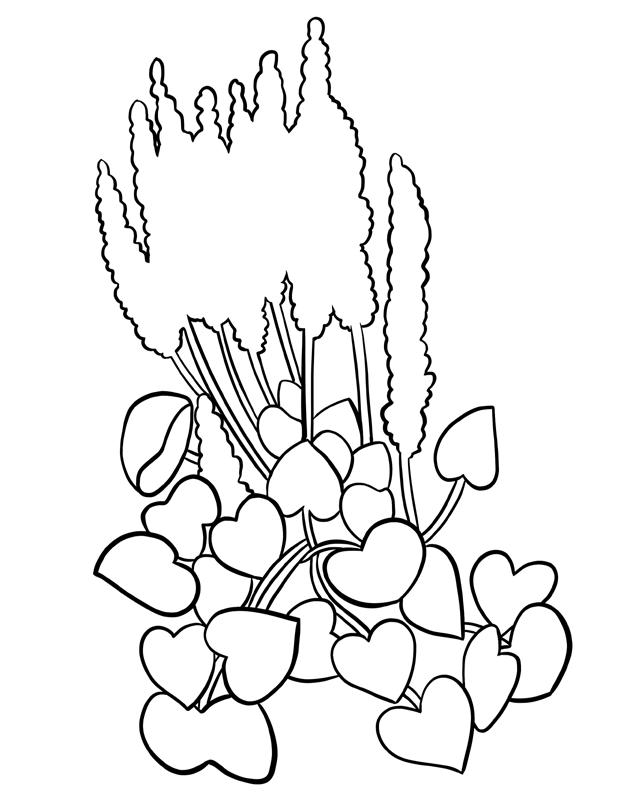
ᐱᓕᕆᐊᒃᓴᖅ: ᐊᑐᓕᒃᑲᓐᓂᖅᓯᒪᔪᑦ ᓄᓇᐃᓐᓇᕐᒥ ᐱᕈᖅᑐᑦ • ᒪᒃᐱᖅᑐᒐᖅ 4 ᐱᖓᓲᔪᖅᑑᑎᓪᓗᒋᑦ ᐊᑎᖅ: ᑐᓂᐅᖅᑲᒐᖅ 7
ᓄᓇᐃᓐᓇᕐᒥ ᐱᕈᖅᑐᑦ

ᐱᓕᕆᐊᒃᓴᖅ: ᐊᑐᓕᒃᑲᓐᓂᖅᓯᒪᔪᑦ ᓄᓇᐃᓐᓇᕐᒥ ᐱᕈᖅᑐᑦ • ᒪᒃᐱᖅᑐᒐᖅ 5 ᐱᖓᓲᔪᖅᑑᑎᓪᓗᒋᑦ ᐊᑎᖅ: ᑐᓂᐅᖅᑲᒐᖅ 7
ᓄᓇᐃᓐᓇᕐᒥ ᐱᕈᖅᑐᑦ

ᐱᓕᕆᐊᒃᓴᖅ: ᐊᑐᓕᒃᑲᓐᓂᖅᓯᒪᔪᑦ ᓄᓇᐃᓐᓇᕐᒥ ᐱᕈᖅᑐᑦ • ᒪᒃᐱᖅᑐᒐᖅ 6 ᐱᖓᓲᔪᖅᑑᑎᓪᓗᒋᑦ ᐊᑎᖅ: ᑐᓂᐅᖅᑲᒐᖅ 7
Tundra Plants Outlines

Activity: Recycled Tundra Plants • 1 of 6 Name: Handout 7
Tundra Plants Outlines

Activity: Recycled Tundra Plants • 2 of 6 Name: Handout 7
Tundra Plants Outlines

Activity: Recycled Tundra Plants • 3 of 6 Name: Handout 7
Tundra Plants Outlines

Activity: Recycled Tundra Plants • 4 of 6 Name: Handout 7
Tundra Plants Outlines

Activity: Recycled Tundra Plants • 5 of 6 Name: Handout 7
Tundra Plants Outlines

Activity: Recycled Tundra Plants • 6 of 6 Name: Handout 7
ᓱᓕᔪᓂᒃ ᑲᓲᑎᑦ: ᖃᐅᔨᓴᖅᑐᓕᕆᓂᖅ
Non-fiction Connections: Science
ᐱᓕᕆᐊᒃᓴᖅ: ᐱᕈᖅᑐᓂᒃ
Activity: Plant Detectives [30 min]
Overview
Students will participate in a “detective” activity in which they will read clues about tundra plants and identify them using a plant glossary.
Materials
• ᑐᓂᐅᖅᑲᒐᖅ 8: ᑭᓲᕗᖓ? / Handout 8: What Am I?
• ᑐᓂᐅᖅᑲᒐᖅ 9: ᐱᕈᖅᑐᑦ ᐅᖃᐅᓯᖅᑕᖏᑦ / Handout 9: Plant Glossary
• Whiteboard or chart paper
Preparation
• Photocopy ᑐᓂᐅᖅᑲᒐᖅ 8: ᑭᓲᕗᖓ? / Handout 8: What Am I? (one for each student).
• Photocopy ᑐᓂᐅᖅᑲᒐᖅ 9: ᐱᕈᖅᑐᑦ ᐅᖃᐅᓯᖅᑕᖏᑦ / Handout 9: Plant Glossary (one for each student).
• On the whiteboard, write: My stems look like braids. I grow in large patches. I am used as fuel for cooking fires. What am I?
Teaching Tip
This activity requires students to do a lot of independent reading. If the required reading is too challenging for your students, consider doing the activity as a class. You can read the clues and glossary out loud as students follow along on their own copy. If you have students at many different reading levels, you may also consider having some students do the activity independently while others listen to you read the activity out loud. Choose the method of delivery that works best for your class.
Activity
1. Have students sit in a shared space. Ask students to recall the plants they learned about in ᐱᕈᖅᑐᑦ ᒥᒃᓵᓄᑦ / A Walk on the Tundra.
2. Explain to students that they are going to read some clues that describe one of the plants they learned about in the book. Tell students that they will use their best “detective skills” to figure out which description matches which plant.
3. Model how you would use your “detective skills” to find important words in the clue. Use what you wrote on the whiteboard as an example. Think out loud as you model the activity. Refer to the handouts as needed.
4. Distribute ᑐᓂᐅᖅᑲᒐᖅ 8: ᑭᓲᕗᖓ? / Handout 8: What Am I? and ᑐᓂᐅᖅᑲᒐᖅ 9: ᐱᕈᖅᑐᑦ
/ Handout 9: Plant Glossary to each student.
5. Students may work independently or in pairs on this activity.
ᐅᖃᓕᒫᒐᕐᒥᒃ ᕿᒥᕐᕈᓂᖅ Book Study 56 ᐱᕈᖅᑐᑦ ᒥᒃᓵᓄᑦ
ᖃᐅᔨᓴᖅᑎᑦ
ᐅᖃᐅᓯᖅᑕᖏᑦ
Extension Activity: Plant Walk
• With an Elder or community expert, take students on a walk on some open land near the community. Look for plants identified in ᐱᕈᖅᑐᑦ ᒥᒃᓵᓄᑦ / A Walk on the Tundra and other plants that grow near your community. Do a plant walk, looking at and talking about the different plants that students see.
• If you do this book study in the winter, print a selection of photographs of tundra plants. Display them around your classroom. Invite an Elder or community expert into your classroom to do a plant walk around your classroom, looking at and talking about the different plants they see.
A WALK ON THE TUNDRA 57 ᓱᓕᔪᓂᒃ ᑲᓲᑎᑦ: ᖃᐅᔨᓴᖅᑐᓕᕆᓂᖅ Non-fiction Connections: Science
ᐱᕈᖅᑐᑎᒎᕐᓂᖅ
ᐱᓕᕆᐊᒃᓴᒃᑲᓐᓂᖅ:
ᑭᓲᕗᖓ?
ᑏᓕᐅᕈᑎᒋᒍᕕᖓ, ᓰᕐᓇᖅᑐᖓ.
ᑕᑭᔪᓂᒃ, ᐆᔭᐅᔭᓂᒃ ᓇᑲᖃᖅᑐᖓ.
ᓄᓇᕋᖁᑎᒃᑲ ᐊᐅᐸᔮᖅᑐᑦ.
ᐃᑯᒪᔾᔪᑕᐅᕙᒃᑐᖓ.
ᑭᓲᕗᖓ?
ᐃᒐᔾᔪᑕᐅᓂᐊᖅᑐᓄᑦ
ᐊᒥᓱᓂ ᐱᕈᖃᑕᐅᕙᒃᑐᖓ.
ᓇᑲᒃᑲ ᐱᕐᕋᖅᓯᒪᖅᑰᔨᔪᑦ.
ᑭᓲᕗᖓ?
ᐱᕈᖅᐸᒃᑐᖓ
ᑐᐊᐸᖃᑦᑎᐊᖅᑐᒥ.
ᓂᐊᖁᙳᔪᓐᓃᕈᑕᐅᕙᒃᖢᑎᒡᓗ.
ᐅᖃᐅᔭᒃᑲ
ᓈᙳᔪᓐᓃᕈᑕᐅᕙᒃᑐᑦ
ᑭᓲᕗᖓ?
ᖃᑯᖅᓯᕙᒃᑐᖓᓗ
ᐅᑭᐊᒃᓵᙳᕌᖓᑦ.
ᐊᐅᔭᙳᕌᖓᑦ
ᐃᓚᓪᓗᒋᑦ.
ᐊᐅᔭᙳᖅᑎᓪᓗᒍ, ᓇᐅᒃᑯᓕᒫᖅ ᒥᖅᑯᒃᐸᒃᑐᖓ. ᐊᐅᐸᖅᐸᒃᑐᖓ
ᐅᖃᐅᔭᒃᑲ ᐱᐅᔪᑦ ᑏᒧᑦ
ᐊᓯᖏᓐᓄᓪᓗ
ᑭᓲᕗᖓ?
ᑕᓪᓕᒪᓂᒃ
ᐅᖃᐅᔭᒃᑲ ᒥᑭᑦᑐᒻᒪᕆᑯᓗᖕᓂᒃ ᑭᒍᑎᖃᖅᑰᔨᔪᑦ.
ᓄᓇᕋᖁᑎᒃᑲ
ᐱᓕᕆᐊᒃᓴᖅ: ᐱᕈᖅᑐᓂᒃ ᖃᐅᔨᓴᖅᑎᑦ • ᒪᒃᐱᖅᑐᒐᖅ 1 ᐊᑕᐅᓯᐅᑎᓪᓗᒍ ᐊᑏᒃ: ᑐᓂᐅᖅᑲᒐᖅ 8 ᑭᓲᕗᖓ? ᐱᕈᖅᑐᓄᑦ ᐅᖃᐅᓯᖅᑕᑦ ᐊᑐᕐᓗᒋᑦ ᐊᑐᓂ ᐱᕈᖅᑐᑦ ᖃᐅᔨᒋᐊᒃᑭᑦ ᑭᓲᖕᒪᖔᑕ. ᐱᕈᖅᑑᑉ ᐊᑎᖓ ᑎᑎᕋᕐᓗᒍ ᐊᑖᒍᑦ.
ᐊᔾᔨᒌᙱᑦᑐᓂᒃ ᑕᖅᓴᓖᑦ.
ᐅᖃᐅᔭᒃᑲ ᐆᒻᒪᑎᙳᐊᖑᖅᑰᔨᔪᑦ. ᖃᒃᑭᓐᓇᖅᖢᖓ ᓰᕐᓇᖅᖢᖓᓗ. ᐊᑦᑎᐊᕆᔭᐅᔪᖓ “ᓄᖑᓴᒐᖅ ᐅᑭᐅᖅᑕᖅᑐᕐᒥ.” ᑭᓲᕗᖓ?
(khee~yook~taat)
Qijuktaat
English: Arctic White Heather, Arctic Bell Heather • Scientific: Cassiope tetragona

• ᐆᔭᐅᔭᐅᓪᓗᑎᒃ ᑕᑭᔪᑯᑖᒡᒍᑎᑯᓘᓪᓗᑎᒃ ᐱᕐᕋᖅᓯᒪᖅᑰᔨᔪᑦ!
• ᓄᕗᕈᑎᖕᒋᑦ ᖃᑯᖅᑕᑦ, ᓯᕙᓂᕈᑎᖖᒍᐊᖕᒍᔮᖅᑐᑦ.
• ᖃᖅᑲᔮᓂ ᐱᕈᓲᑦ ᑲᑎᒻᒪᐅᖅᑐᐊᓘᓪᓗᑎᒃ.
ᖁᖑᓖᑦ Qunguliit (khoong~oo~leet)
English: Mountain Sorrel, Sweet Leaves • Scientific: Oxyria digyna
• ᓇᑲᖏᑦ ᐊᐅᐸᖅᑐᑦ ᐊᒻᒪᓗᖅᑐᕋᓛᑯᓗᓐᓂᒃ.
ᓇᑲᖕᒋᑦ ᖁᖕᒍᓕᖕᒋᓐᓄ ᓰᕐᓇᕈᔪᒃᑐᑯᓗᐃᑦ.
ᒪᒪᓛᖕᒍᔪᑦ ᐊᒃᓴᓕᒃᓯᒪᓪᓗᒋᑦ, ᑲᑎᕈᓘᔭᖅᑐᒋᑦ ᓂᕆᔭᕆᐊᒃᓴᖅ. ᑕᐃᒫᑐᐃᓐᓇᖅ, ᐆᓯᒪᑎᓐᓇᒋᑦ ᓂᕆᔭᒃᓴᐃᑦ. ᐆᑦᑎᔭᐅᔪᓐᓇᕐᒥᔪᑦ. ᐊᐅᔭᓕᒫᑦᑎᐊᖅ ᖁᖕᒍᓖᑦ ᓂᕆᔭᒃᓴᐃᑦ. ᑭᓯᐊᓂ ᐱᐅᓛᖕᒍᖃᑦᑕᖅᑐᑦ ᐊᐅᔭᓪᓚᕆᒃᑯᑦ.
ᐱᓕᕆᐊᒃᓴᖅ: ᐱᕈᖅᑐᓂᒃ ᖃᐅᔨᓴᖅᑎᑦ • ᒪᒃᐱᖅᑐᒐᖅ 1 ᒪᕐᕉᑎᓪᓗᒋᒃ ᐊᑎᖅ: ᑐᓂᐅᖅᑲᒐᖅ 9 ᑐᑭᓯᒋᐊᕈᑎᑦ ᐱᕈᖅᑐᑦ ᒥᒃᓵᓄᑦ
ᕿᔪᒃᑖᑦ
• ᐅᖃᐅᔭᖕᒋᑦ ᐆᒻᒪᑎᖖᒍᐊᖕᒍᔮᖅᑐᑦ.
ᕿᔪᒃᑖᑦ ᐃᒐᔾᔪᑕᐅᓲᑦ. ᐳᔪᖓ ᑎᐱᑦᑎᐊᕆᒃᑐᒻᒪᕆᒃ ᐊᒻᒪᓗ ᒪᒪᕈᑕᐅᓲᑦ ᐃᒑᓄᑦ. ᖁᖑᓖᑦ ᒪᒪᖅᑐᒻᒪᕆᑯᓗᐃᑦ!
“ᐅᑭᐅᖅᑕᖅᑑᑉ ᐅᖁᒻᒥᐊᒐᖕᒋᓐᓂᒃ.”
ᐃᓚᖕᒋᓐᓄᑦ ᖃᐅᔨᒪᔭᐅᔪᑦ
English: Arctic Willow • Scientific: Salix arctica
Uqaujait (oo~kha~oo~ya~eet)

• ᑲᑎᙵᓪᓗᑎᒃ ᐱᕈᓲᑦ, ᓯᐅᕋᕈᔪᒻᒥ ᐱᓗᐊᖅᑐᒥᒃ ᖃᓗᔭᐅᓯᒪᔪᕈᔪᓐᓂ.
English: Dwarf Fireweed, River Beauty • Scientific: Chamerion latifolium
Paunnait (pa~oo~na~eet)
English: Hairy Lousewort • Scientific: Pedicularis hirsuta
Ujjurnak (ooj~joon~nakh)
English: Arctic Thrift, Sea Pink • Scientific: Armeria scabra
A’aasaaq (ah~ah~sak)
ᐱᓕᕆᐊᒃᓴᖅ: ᐱᕈᖅᑐᓂᒃ ᖃᐅᔨᓴᖅᑎᑦ •
ᒪᕐᕉᑎᓪᓗᒋᒃ ᐊᑎᖅ: ᑐᓂᐅᖅᑲᒐᖅ 9 ᐸᐅᓐᓇᐃᑦ
ᒪᒃᐱᖅᑐᒐᖅ 2
ᐊ’ᐋᓵᖅ
ᐅᔾᔪᕐᓇᒃ
ᐅᖃᐅᔭᐃᑦ/ᓱᐳᑎᑦ
• ᐱᕈᖅᑐᖅ ᑎᓴᒪᓂᒃ ᐊᐅᐸᕈᔪᒃᑐᓂᒃ ᐅᖃᐅᔭᐅᔭᓕᒃ.
ᐅᖃᐅᔭᖃᖅᑐᑎᒃ ᑐᖕᒍᑦᑐᕆᑦᑐᓂᒃ (ᐆᔭᐅᔭᓪᓚᕆᓐᓂᒃ) ᕿᓪᓕᖕᒋᑦᑐᓂᒃ.
•
ᖃᑲᔮᓂ ᐊᒻᒪᓗ ᓯᔾᔨᖅᐸᓯᖕᒥ. • ᐱᕈᖅᑐᖕᒋᑦ ᐊᐅᐸᕈᔪᒃᑐᑦ. • 30-50ᓘᓐᓃᑦ ᑲᑎᒻᒪᓲᑦ, ᐊᑕᐅᓯᐊᓘᔮᖃᑦᑕᖅᑐᑦ ᑲᑎᒻᒪᓪᓗᑎᒃ. •
ᐆᔭᐅᔭᐃᑦ ᐊᒥᑦᑐᑯᑖᑯᓘᓪᓗᑎᒃ, ᐅᖃᐅᔭᖏᑦ ᓄᓇᒧᑦ ᑐᙵᓲᑦ. •
ᖃᑯᖅᑕᐅᒐᔪᑦᑐᖅ, ᑭᓯᐊᓂ ᐃᓛᓐᓂᒃᑯᑦ ᐊᐅᐸᖅᑐᖅ, ᐃᔅᓯᐅᓲᑦ, ᖁᖅᓱᕈᔪᒃᑐᖅ ᐊᒻᒪᓗ ᐆᔭᐅᔭᕈᔫᓲᑦ. ᑲᑎᒻᒪᕈᔪᑦᑐᑎᒃ ᐱᕈᓲᑦ. • ᐊᑕᐅᓯᖅ ᐱᕈᖅᑐᖅ ᑕᓪᓕᒪᓂᒃ ᐅᖃᐅᔭᐅᔭᖃᓲᖅ. ᒪᕐᕉᒃ ᖄᖕᒐᓂ ᐱᕈᖅᑑᒃ, ᐱᖕᒐᓱᑦ ᐊᑖᓃᑦᑐᑎᒃ. ᐊᑖᓃᑦᑐᑦ, ᖄᖕᒐᓃᑦᑐᓂᒃ ᓯᓕᓐᓂᖅᓴᐃᑦ. • ᐅᖃᐅᔭᖕᒋᑦ ᑭᒍᑎᕋᓛᓕᐊᓘᔮᖅᑐᑦ ᑭᓯᐊᓂ ᑲᑭᓪᓚᕐᓇᖕᒋᑦᑐᑦ. • ᐅᖃᐅᔭᖕᒋᑦ ᓄᕗᓖᑦ ᐆᔭᐅᔭᐅᓪᓗᑎᒃ. • ᐅᖅᑰᓯᕙᓪᓕᐊᓕᖅᑎᓪᓗᒍ ᐅᖃᐅᔭᖕᒋᑦ ᒥᖅᑯᖃᕈᔪᓲᑦ. • ᓱᐳᑎᖕᒋᓐᓄᑦ ᓇᓗᓇᖕᒋᑦᑎᐊᓲᑦ. ᓱᐳᑎᖕᒋᑦ ᐊᐅᔭᕋᑖᒥ ᐊᐅᐸᖅᑑᓲᑦ, ᑭᓯᐊᓂ ᐊᐅᔭᐅᑐᖃᓕᕌᖕᒐᑦ ᖃᒃᑯᑑᓕᖃᑦᑕᖅᑐᑦ ᐱᖅᑯᓕᐊᓘᓪᓗᑎᒃ. ᐅᖃᐅᔭᖕᒋᑦ ᐸᐅᓐᓇᐃᑦ ᐊᑐᖅᑕᐅᔪᓐᓇᑦᑎᐊᖅᑐᑦ ᐊᔾᔨᒌᖕᒋᑦᑐᓄᑦ. ᓂᕆᑐᐃᓐᓇᕋᒃᓴᐅᔪᑦ ᐊᒻᒪᓗ ᓈᕐᓗᕈᔪᒃᑐᓄᑦ ᐱᐅᓪᓗᑎᒃ. ᑏᖖᒍᐊᓕᐊᖕᒍᓲᖕᒍᒻᒥᔪᑦ. ᐃᓱᑦᑎᐊᖅᑐᐊᓗᒻᒥᒃ ᑏᖖᒍᐊᓕᐊᖅ ᓂᐊᖁᖖᒍᔪᓄᑦ ᐊᑲᐅᓯᓇᓂᕋᖅᑕᐅᔪᖅ. ᐅᖃᐅᔭᖕᒋᑦ ᐅᐱᕐᖕᒑᒃᑯᑦ ᓄᐊᓚᐅᖅᑐᒋᑦ, ᐅᑭᐅᓕᒫᖅ ᑏᖖᒍᐊᓕᐊᖕᒍᔪᓐᓇᖅᑐᑦ. ᐱᕈᖅᑐᖕᒋᑦ ᑏᖖᒍᐊᓕᐊᖕᒍᓲᑦ, ᐃᓱᖅᑐᐊᓘᖕᒋᑦᑎᐊᖅᑐᑦ. ᐅᔾᔪᓐᓇᑦ ᑏᖖᒍᐊᑦᑎᐊᕙᒃ. ᐱᕈᖅᑐᖕᒐ ᑕᐳᑦᑖᑦ ᓂᕆᔭᒃᓴᖅ. ᐅᖃᐅᔭᖏᑦ ᓂᕆᔭᒃᓴᐃᑦ. ᐅᖅᓯᖅᑐᒋᑦ ᒪᒪᖅᑐᐊᓘᒻᒥᔪᑦ, ᐸᐅᕐᖓᓂᒃ ᐃᓚᖃᓈᖅᐸᑦᑐᒋᓪᓗ. ᑏᖖᒍᐊᓕᐊᖕᒍᓲᖕᒍᒥᔪᑦ ᐅᖃᐅᔭᖕᒋᑦ.
ᐱᑕᖃᒐᔪᒃᑐᑦ ᐊᖅᑯᑎᐅᑉ ᑭᓪᓕᖕᒋᓐᓂ,
ᓇᑲᖏᑦ
ᐱᕈᖅᑐᖕᒐ (ᓱᐳᑎᐅᔭᖕᒐ)
Handout
What Am I?
Use the Plant Glossary to discover the identity of each plant. Write the plant’s name on the line below the description.
My leaves look like they have very small teeth. My blossoms can be five different colours. What am I?
My leaves are good in tea and for making other treats. In the early summer, I have little hairs all over. I am red in the early summer and white in the late summer. What am I?
My stems look like braids. I grow in large patches. I am used as fuel for cooking fires. What am I?
My leaves are heart-shaped. I taste tangy and sweet. My nickname is “Arctic candy.” What am I?
My leaves help heal an upset stomach or a headache. I often grow where there’s lots of gravel. What am I?
My blossoms are pink. I have a long green stem. When you make tea out of me, I taste fruity. What am I?
Activity: Plant Detectives • 1 of 1
Names:
8

Name: Handout 9 Activity: Plant Detectives • 1 of 2

Activity: Plant Detectives • 2 of 2 Name:
9
Handout
Extension Activities across the Subjects
ᓴᓇᕈᓘᔭᕐᓂᖅ
Art
• Use a different medium (such as pastels and watercolours) to illustrate different tundra plants. Write labels to name each plant. Display the plants and labels together on a bulletin board.
ᐱᓪᓚᕆᖖᒍᐊᕐᓂᖅ
Drama
• Students can write and act out a short scene that highlights one of their favourite experiences on the land with family.
ᓄᓇᙳᐊᖅ
Geography
• Provide some information about plants that different Indigenous groups traditionally use for nutrition and medicine (such as northern white-cedar, seaweed, and cranberries). Compare and contrast with the plants that are described in the book.
ᐋᓐᓂᐊᖅᑕᐃᓕᒪᓂᖅ
Health
• Discuss the nutritional value of eating different edible tundra plants.
• Examine the relationship between Inuujaq and Silaaq. What characteristics of a positive relationship do Inuujaq and Silaaq show us? Write a short paragraph describing one of the positive relationship qualities that Inuujaq and Silaaq have.
ᐅᖃᓕᒫᒐᕐᒥᒃ ᕿᒥᕐᕈᓂᖅ Book Study 64 ᐱᕈᖅᑐᑦ ᒥᒃᓵᓄᑦ
ᑕᒪᐃᓐᓄᑦ ᐃᓕᓐᓂᐊᒐᒃᓴᓄᑦ
ᐱᓕᕆᐊᒃᓴᒃᑲᓐᓃᑦ
ᓈᓴᐅᓯᕆᓂᖅ Math
• Using grouping strategies, estimate how many plants are on any one page.
Music
• Create a “soundscape” of Inuujaq and Silaaq’s walk across the tundra. Have groups of students create the sound of the wind, the sound of feet walking on rocks and grass, the sound of picking plants, and so on.
ᖃᐅᔨᓴᖅᑐᓕᕆᓂᖅ Science
• Draw one of the tundra plants from the book. Label the parts of the plant (stem, leaves, petals, and so on).
• Grow some plants from seed. Observe the daily changes of the plants and how sunlight, water, and soil affect their growth.
ᐃᓅᓯᓕᕆᓂᖅ Social Studies
• Invite an Elder to your classroom to explain how people in your regions traditionally used plants (before the introduction of southern food). Discuss how people in your community use tundra plants now. Discuss the similarities and differences between gathering plants on the tundra and going to the store to buy vegetables to eat.
A WALK ON THE TUNDRA 65 ᐱᓕᕆᐊᒃᓴᒃᑲᓐᓃᑦ ᑕᒪᐃᓐᓄᑦ ᐃᓕᓐᓂᐊᒐᒃᓴᓄᑦ Extension Activities across the Subjects
ᓂᔾᔭᐅᓯᔭᕐᓂᖅ
ᐅᖃᓕᒫᒐᕐᒥᒃ ᕿᒥᕐᕈᓂᖅ Book Study 66 ᐱᕈᖅᑐᑦ ᒥᒃᓵᓄᑦ
A WALK ON THE TUNDRA 67
ᐅᖃᓕᒫᒐᕐᒥᒃ ᕿᒥᕐᕈᓂᖅ Book Study 68 ᐱᕈᖅᑐᑦ ᒥᒃᓵᓄᑦ
A WALK ON THE TUNDRA 69
ᐅᖃᓕᒫᒐᕐᒥᒃ ᕿᒥᕐᕈᓂᖅ Book Study 70 ᐱᕈᖅᑐᑦ ᒥᒃᓵᓄᑦ
A WALK ON THE TUNDRA 71
A Walk on the Tundra

| Book Study
The ᓄᓇᒥ ᐱᓱᔪᖕᓂᖅ / A Walk on the Tundra book study is part of Inuktut Titiqqiriniq, a comprehensive literacy program that was developed by Nunavut educators, linguists, and language consultants, with constant testing and input by Nunavut classroom teachers. Inuktut Titiqqiriniq provides instructional tools and resources to help students develop strong Inuktut language skills.
This resource provides activities based on ᓄᓇᒥ ᐱᓱᔪᖕᓂᖅ / A Walk on the Tundra , by Rebecca Hainnu and Anna Ziegler. The book follows Inuujaq, a bored little girl who travels with her grandmother onto the tundra. There, Inuujaq learns that the tough little plants growing there are much more important to Inuit than she originally believed. Students will participate in a variety of listening, speaking, reading, writing, viewing, and representing activities as they learn about different tundra plants and what they can be used for.
ᐅᖃᓕᒫᒐᕐᒥᒃ ᕿᒥᕐᕈᓂᖅ





































